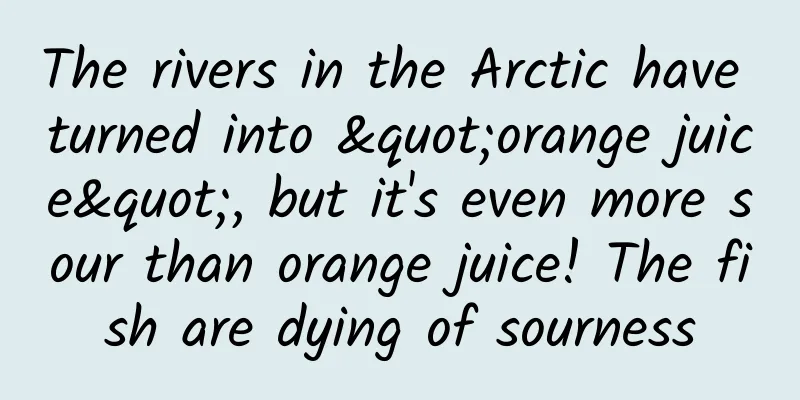The rivers in the Arctic have turned into "orange juice", but it's even more sour than orange juice! The fish are dying of sourness

|
Image source: medium Alaska is a place with magnificent natural scenery, but scientists have recently discovered that the rivers there are becoming more and more "orange" . One of the rivers is the most orange, the Kobuk River (pictured below), which winds through northwestern Alaska for about 451 kilometers. Image credit: Taylor Roades The river looked polluted, as if it had been filled with carrot juice, and its surface shimmered with a gasoline-like rainbow luster. In order to understand why the water here has turned color, scientists came to Alaska to study the water quality of different river basins. When scientists used a pH tester to check the pH value of the rivers, they found that the pH values of these rivers were extremely low, with the lowest pH value being only 3.5 , which is much lower than orange juice, which is also orange, and humans cannot drink it at all. Image credit: Taylor Roades Originally, rivers in such remote areas should not be affected by environmental pollution. In 1975, when writer John McPhee was traveling by boat on a river in Alaska, he said, "This is the clearest and purest water I have ever seen." But now the more than 110-kilometer-long river here is "rusty." In the orange river water, scientists have found a large amount of iron oxide minerals, which also contain a large amount of acidic substances. Image credit: Taylor Roades Why do Alaskan rivers contain so much iron oxide? Scientists believe that climate change is the main reason for this . Rising temperatures in the region cause permafrost to melt, releasing iron that was previously locked in the frozen soil. When the river passes through the land containing iron, the iron reacts with the air and water to form what we commonly know as rust. It is this rust that makes the river water look orange. Imagine that the water is flowing through a huge rusty iron gate, and the water is naturally dyed. Orange watershed image source: USGS/Public Domain The Arctic is warming nearly four times faster than the rest of the world, and northern Alaska is no exception. Kobuk Valley National Park in Alaska has already warmed 2.4 degrees Celsius since 2006 and could reach an additional 10.2 degrees Celsius by 2100, higher than any other national park projected. However, there is another view that the orange color comes not only from iron, but also from microorganisms. Some scientists believe that during the thawing process of permafrost, some microorganisms hidden in the permafrost are released and revived, and then absorb the iron in the soil. In any case, it is related to iron. Image source: Internet With such high concentrations of iron and acid in the river, the fish in the water naturally cannot survive. A pH of about 7 is the neutral point for water, and many fish live most comfortably in waters close to this pH. Of course, some fish, such as many tropical fish species in the Amazon River basin, have adapted to slightly acidic water environments. When biologist Mike Carey flew to Alaska by helicopter in August 2018 to retrieve a water sensor, he found that the streams there were almost devoid of fish or other insects. For salmon, under acidic or alkaline conditions, they may face multiple physiological stresses, which may lead to reduced growth, reduced reproductive capacity, and even death. Iron oxide in the water also has a great impact on their survival because iron oxide particles may be deposited on the gills of fish, affecting their breathing. Gills are organs that fish use to extract oxygen from water. If the gills are blocked, fish may have difficulty getting enough oxygen, leading to suffocation. Image source: Internet If the fish can't survive, the lives of local fishermen will naturally be affected. First, pollution can lead to a decrease in the number of fish, especially sensitive species such as salmon. This directly affects the fishermen's catch and income. Even if the fish survive, pollution may affect their quality, as heavy metals and other toxic chemicals may accumulate in the fish, posing health risks to people who eat these fish, thereby reducing market demand and sales prices. There is actually a similar phenomenon in Antarctica, and it looks more terrifying than the orange river in the Arctic, like a blood waterfall. In Taylor Glacier in Antarctica, dark red liquid emerges from cracks on the surface of the glacier, soaking the surrounding ice surface, and seems to be frozen blood oozing out of humans. Image credit: Peter Rejcek/NSF/Public Domain The reason for the Blood Falls is the high concentration of iron ions, which is much higher than the iron ions in the orange rivers of the Arctic . The high concentration is caused by the concentration of salt during the crystallization of ancient seawater. Due to the heat exchange between the huge ice blocks of the glacier and the trapped liquid seawater, the pure ice crystallized and expelled the dissolved salts during the cooling process, causing salt condensation in the deep residual seawater. Not only in the Antarctic and the Arctic, but also in other places, rivers affected by iron have been seen. In early 2023, astronauts on the International Space Station (ISS) saw a red river visible to the naked eye on Earth, located in the Betsiboka River Delta in Madagascar, where the water is rich in iron sediments, so it turns a rich red. Image credit: ISS/NASA Image credit: ISS/NASA Have you ever seen a river that looks like orange juice? References [1]https://www.usgs.gov/centers/alaska-science-center/science/rusting-arctic-rivers-freshwater-ecosystems-respond-rapidly#overview [2]hhttps://www.scientificamerican.com/article/why-are-alaskas-rivers-turning-orange/ Planning and production Source: Bringing Science Home (id: steamforkids) Author: Su Chengyu Review丨Skin Editor: Yinuo |
>>: Nature News: AI is close to human gold medalists in solving high school math Olympiad problems
Recommend
Taking "Suning Store" as an example, a three-dimensional analysis of the O2O online operation of community convenience stores
According to the statistics bureau, in 2015, the ...
Negotiations on a global "plastic ban" are underway. Can it control all countries?
Today, a global "plastic ban" is about ...
Chen Yifeng's "Practical Textbook on Finding Dragon Points" A set of 8 pdf books on Finding Dragon Points can be downloaded from Baidu Cloud!
Chen Yifeng's "Practical Textbook on Fin...
The highest level of operation is to achieve great results with little effort. Let’s talk about the cost awareness of operators!
I must single this out. The highest level of an o...
Wuwei teacher Li Dong's "Bull Stock Special Training Camp" from a novice to a stock picking expert
3 seconds to see through the main force's int...
Five common misunderstandings about APP promotion and download, have you fallen into them?
Misconception 1: Thinking that code release will ...
Deconstructing the universal formula for e-commerce operations!
E-commerce operation is the most special operatio...
"Nobel Prize Vane" - 2023 Lasker Award announced! AlphaFold developers and others on the list
Known as the "Nobel Prize weathervane",...
No idea on how to leverage brand marketing on Teachers’ Day? Come on~
A few days ago, I wrote a copy for Teacher's ...
The October marketing calendar is here, here are some tips for planning alternative events!
The so-called pendulum theory, It is said that ma...
Can you buy your privacy for 300 yuan?! How terrible is "opening the box"...
Is your privacy still safe? Do you dare to believ...
Can betting on celebrity reality shows pave the way for video networks?
Ever since Hunan TV's variety show "Wher...
The latest method to attract traffic and promote Toutiao today!
Why choose Toutiao ? Yesterday I saw someone aske...
The three chip giants have entered the autonomous driving market, and Chinese manufacturers such as Huawei have made a single breakthrough and are facing the ultimate test
Qualcomm, Intel and Nvidia, the three giant chip ...
Google Glass will stop taking orders and move from Google X to a new division
Google said it will stop taking orders for Google ...









